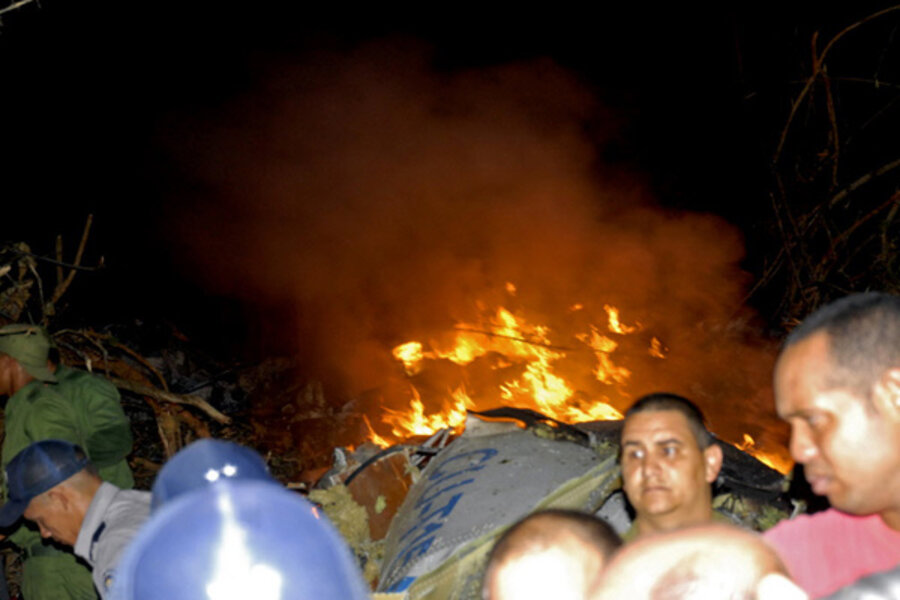Plane crashes in Cuba, kills all 68 aboard
Loading...
| GUASIMAL, Cuba
A state airliner filled with Cubans and travelers from Europe and Latin America crashed and burst into flames in a mountainous area after declaring an emergency and losing contact with air traffic controllers, the island's worst air disaster in more than 20 years.
All 40 Cubans and 28 foreigners aboard died, authorities announced early Friday.
AeroCaribbean Flight 883 was en route from the eastern city of Santiago de Cuba to the capital when it reported an emergency at 5:42 p.m. local time Thursday, then lost contact with air traffic controllers. It went down near Guasimal, a village in Sancti Spiritus province, carrying 61 passengers and a crew of seven.
Cuba's Civil Aviation Authority issued a statement hours later saying there were no survivors. It released a list of passengers that included nine Argentines, seven Mexicans, three Dutch citizens, two Germans, two Austrians, a French citizen, an Italian, a Spaniard, a Venezuelan and a Japanese. The seven member crew were all Cuban, as were 33 passengers.
Emergency vehicles lined a road about 2 miles (3 kilometers) from the crash site, and journalists were not permitted to get any closer to the wreckage in a remote and rugged area.
Photos posted on the website of the local newspaper, Escambray, showed a large piece of the plane in flames, with rescue workers in olive-green military uniforms standing around it. Others showed rescue workers using a bulldozer to reach the remote site.
Another picture showed an image of the AeroCaribbean plane in happier times, painted white, yellow and blue, and adorned with images of bending palm trees.
The paper said the local Communist Party chief as well as Interior Ministry and other officials were at the scene helping with the effort.
The twice-a-week AeroCaribbean flight goes from Port-au-Prince, Haiti, to Santiago de Cuba to Havana. State media said that the plane was an ATR-72 twin turboprop and that the crash site was not far from the Zaza reservoir, the largest in Cuba. It said authorities had mobilized doctors and emergency workers in the rural area, which is about 220 miles (350 kilometers) east of Havana.
Javier Figueroa, an official at the Argentine Embassy in Havana, told The Associated Press on Friday that the mission had been inundated with calls from desperately worried relatives in his country. He said Argentine President Cristina Fernandez was readying a plane to ferry family members of the victims to Cuba, but it was not clear when it would arrive.
"We have been in contact with the (Cuban) Foreign Ministry and Civil Aviation about the rescue efforts, which are being made more difficult because of the area's rugged conditions," Figeroa said. "That is making identifications more complicated."
Figueroa said the Argentines on board appeared to be tourists — not residents. He said they did not belong to a single tour group.
At Havana's national terminal late Thursday, relatives of those on board the plane were kept isolated from other passengers and journalists.
"This is very sad," Caridad de las Mercedes Gonzalez, who was manning an airport information desk, said before officials announced that everyone had been killed. "We are very worried. This has taken us by surprise."
Cuban media was quick to release the passenger manifest, but details on the crash itself were hard to come by in a country whose press is tightly controlled.
A state television newscast hours after the crash led with news of an American ballet company's visit to Cuba, then reported on a Transportation Ministry decree that said travelers would be reimbursed or rescheduled if their trips were interrupted by tropical weather in eastern Cuba.
The announcers made no mention of the crash until they read a short statement toward the end of the broadcast. Subsequent newscasts just after midnight and in the early morning gave no details other than to repeat the same statement.
State media gave no details on what happened to the airliner, saying only that the cause of the crash was being investigated.
The flight would have been one of the last leaving Santiago de Cuba for Havana ahead of Tropical Storm Tomas, which was on a track to pass between Cuba's eastern end and the western coast of Haiti on Friday. Cuban media said earlier that flights and train service to Santiago were being suspended until the storm passed.
AeroCaribbean is owned by Cuban state airline Cubana de Aviacion.
The crash was the deadliest in Cuba since a chartered Cubana de Aviacion plane en route from Havana to Milan, Italy, went down shortly after takeoff in September 1989, killing all 126 people on board, as well as 24 people on the ground.
The last sizable passenger plane crash on the island occurred in March 2002, when a Soviet-made biplane carrying 16 people — including 12 foreigners — plunged into a small reservoir in central Cuba. The plane was operated by a small local charter company called Aerotaxi.





